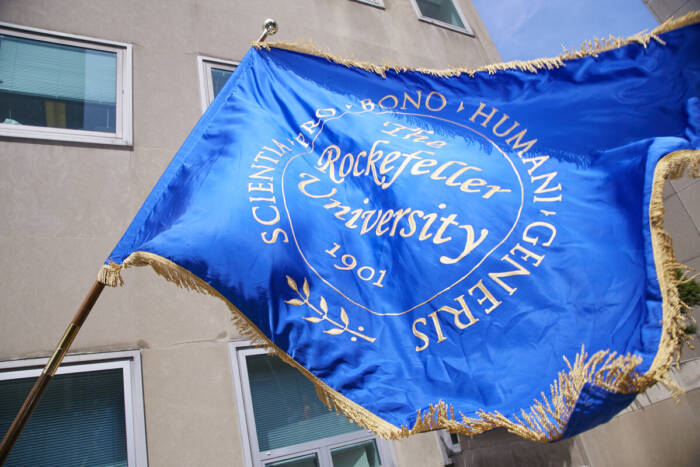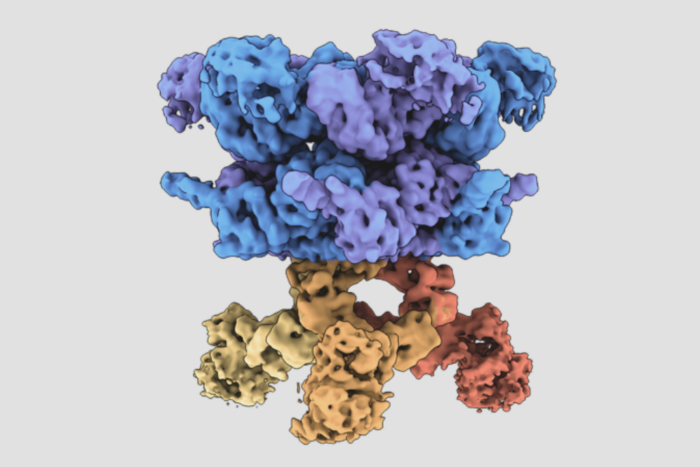Alumna Vanessa Ruta named to university's faculty
by ZACH VEILLEUX
Vanessa Ruta, a Rockefeller alumna who did her doctoral studies in Roderick Mac-Kinnon’s lab, graduating in 2005, has joined the university as assistant professor and will establish the Laboratory of Neurophysiology and Behavior. She moved from a postdoc at Columbia University on September 1.
Dr. Ruta is a neuroscientist interested in understanding how circuits in the brain can be modified by experience, and she has approached her work from a variety of angles over the years. As a graduate student her focus was on structural biology, and during her time in the MacKinnon lab she was instrumental in solving the structure of a voltage-dependent potassium ion channel, a pore in the cell membrane of a neuron that controls the flow of charged particles into and out of the cell. Because the flow of these charged particles generates the electrical signals that neurons use to encode information, ion channels are central to the most basic functions of the nervous system, including the ability to think, feel and move.
More recently, as a postdoc in Richard Axel’s lab at Columbia, Dr. Ruta began to explore how these electrical signals are used by neurons connected within a circuit, turning her attention to defining neural circuits that underlie instinctive behaviors in Drosophila fruit flies. “I reasoned that just as a crystal structure could reveal the molecular mechanisms underlying an ion channel’s function, the delineation of a neural circuit might provide insight into the mechanisms that underlie sensory-evoked behaviors,” Dr. Ruta says.
Dr. Ruta, who majored in chemistry at Hunter College, first became interested in neuroscience while spending the summer at the Marine Biological Laboratory in Woods Hole, Massachusetts as an undergrad. Although she originally aspired to be a ballet dancer — and in fact spent four years after high school dancing in New York City — she changed her mind after enrolling in an introductory chemistry course.
“Studying chemistry was quite a revelation to me,” says Dr. Ruta. “The logic of the physical principles that govern chemical reactions seemed in extreme contrast to my life in the highly subjective ballet world, where you were judged on the whim of a director or choreographer.”
It was at Woods Hole that Dr. Ruta, who was studying visual processing in the horseshoe crab (with another Rockefeller alum, Bob Barlow), first met Dr. MacKinnon and suddenly knew what she wanted to do. “Rod’s work was so elegant and eloquent, and his enthusiasm for his research was overwhelming,” she recalls. “I applied to Rockefeller and began working in Rod’s lab even before I could officially enroll.”
In Dr. Axel’s lab, she developed tools that allowed her to define which of the fly’s 100,000 neurons were involved in responding to a pheromone, beginning from the moment the chemical stimulus was first detected in the air and ending when the fly could modify its behavior in reaction. This ability to literally trace the path of a complete neural circuit, one synapse at a time, gave her the opportunity to address questions about how neural pathways were structured to generate certain behaviors, such as why males and females have different behavioral responses to the same pheromone.
At Rockefeller, Dr. Ruta intends to exploit the simplicity of the fly nervous system to explore the neural mechanisms that allow a fly to flexibly adapt its behavior depending on previous experience. Her initial work will focus on the complex courtship ritual that male fruit flies instinctively perform to entice females to mate. Males learn to suppress this behavior after being rejected by a female, suggesting that the neural circuits underlying the courtship ritual are functionally altered through experience. Dr. Ruta wants to understand in detail how the circuits become modified, and how those modifications, in turn, alter behavior.
“It’s a great paradigm to begin to understand more complex neural processing,” Dr. Ruta says. “There’s likely a certain logic in the fly circuitry that is parallel to that seen in the mammalian brain from mice to humans. Understanding how these circuits change will help us understand our own brain’s ability to adapt, learn and remember, and might suggest what goes wrong in neuropsychiatric and neurodegenerative disease.”
“Vanessa’s studies will help illuminate a fundamental aspect of brain function and may also aid in the development of new treatments for mood, behavioral and memory disorders,” says Marc Tessier-Lavigne, the university’s president. “Vanessa is an exceptional scientist and will be a superb addition to our community. We are thrilled to have recruited her here.”



